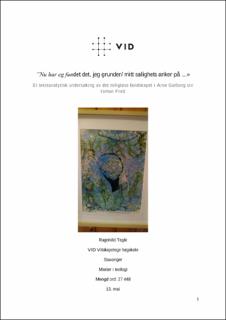| dc.contributor.author | Tegle, Ragnhild | |
| dc.date.accessioned | 2022-10-13T08:15:40Z | |
| dc.date.available | 2022-10-13T08:15:40Z | |
| dc.date.issued | 2022-05 | |
| dc.identifier.uri | https://hdl.handle.net/11250/3025783 | |
| dc.description.abstract | I denne masteroppgåva har eg undersøkt det religiøse landskapet i Arne Garborg sin roman
Fred. Religiøsiteten i Fred har det naturlegvis vore skrive mykje om. Ein må køyra slalåm
gjennom boka for ikkje å koma inn på emnet. Sjølv naturen bér i seg eit teologisk preg den
mest hardbarka ateisten ikkje kan lukka auga sine for. I det følgande skal eg ta ein kort
gjennomgang av resepsjonshistoria si forståing av Fred sin religion, men først vil eg med nokre
få ord presentera det eg sjølv har gjort.
Medan mange før meg har tolka boka anten opp i mot diskursen om samfunnsendring
eller Garborg sin biografi eller begge deler, har eg haldt meg til det dikteriske universet. Det
vil sei at eg fortrinnsvis har vore oppteken av dei kunstnariske og narratologiske grepa Garborg
gjorde, då han konstruerte sitt religiøse landskap. All skjønnlitteratur er kunst og ein kan ikkje
fortelje ei soge utan å ha eit narrativ, men ein kan formidle utan å vera poetisk og symbolsk.
Eg har i mi undersøking tolka religiøsiteten som kjem til utrykk i Fred, ut i frå Garborg sin
bruk av metaforar, symbolikk og allusjonar: For sjølv dei mest banale utsegna til Enok viser
seg å vera tillagt ein viss tvitydigheit som etter mi meining ikkje ironisk, som mange tenker,
men mystisk, og i aller høgaste grad religiøs, men kanskje på ein anna måte enn det me før har
tenkt. | en_US |
| dc.description.abstract | In this master thesis, I have studied the religious landscape in the novel Peace, written by the
Norwegian author Arne Garborg. The religiosity of Peace has been studied a thousand times
before. One must read blindfolded to not take notice of the spirutual theme. Even the nature
in Peace bears witness to a sort of theology the most zealous atheist can't avoid seeing. In the
following chapter, I will introduce the reception history’s answer to my subject matter.
But first I will shortly present what I have done in my analysis. While many before me have
interpreted the novel according to theories of societal change or the biography of Arne Garborg
or both, I have stuck to the universe of fiction. In a direct sense, that has come to mean a focus
on the artistic and narratological tools Garborg has used to construct his spiritual climate. All
fiction is art, and every story must contain a narrative, but it does not have to be poetical and
symbolic. I’ve dedicated myself to interpreting the religiosity we encounter in Peace by emphasizing Garborg's use of metaphors, symbols, and allusions. Even the most commonplace
saying of Enoch seems to contain a certain ambiguous meaning, which is as I see it not
ironically intended by the author, but mystically and certainly religious, but maybe not in the
sense we’ve previously received it. | en_US |
| dc.language.iso | nno | en_US |
| dc.rights | Attribution-NonCommercial-NoDerivatives 4.0 Internasjonal | * |
| dc.rights.uri | http://creativecommons.org/licenses/by-nc-nd/4.0/deed.no | * |
| dc.subject | skjønnlitteratur | en_US |
| dc.subject | tekstanalyse | en_US |
| dc.subject | religiøsitet | en_US |
| dc.title | ”Nu har eg fundet det, jeg grunder/ mitt salighets anker på …» Ei tekstanalytisk undersøking av det religiøse landskapet i Arne Garborg sin roman Fred | en_US |
| dc.type | Master thesis | en_US |
| dc.description.version | publishedVersion | en_US |
| dc.rights.holder | © 2022 Forfatteren | en_US |
| dc.source.pagenumber | 81 | en_US |

